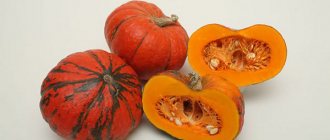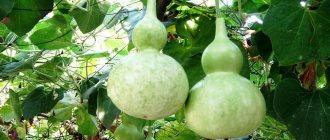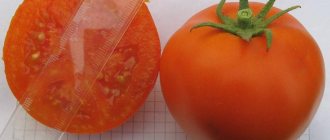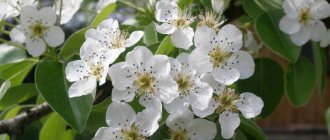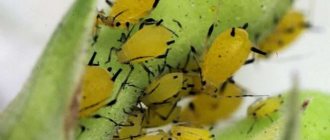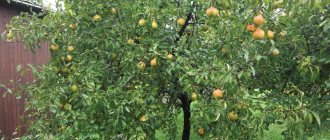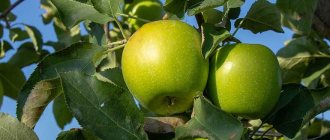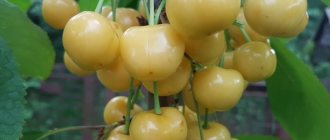Pumpkin is an amazing product, because not only the pulp of the vegetable is eaten, but also the seeds and even the flowers. Finding a pumpkin today is as easy as shelling pears; at the market or in the store they offer vegetables for every taste and color. However, they cannot compare with crops grown on your own plot.
The Smile pumpkin variety is recognized as one of the sunniest and most attractive. Let's consider further why the Smile is so valued and what are the secrets of its cultivation.
Pumpkin Smile: variety description, cultivation, photos and reviews from gardeners
Pumpkin Smile – a hybrid of Russian selection
. The variety was bred in 2000, when there was an urgent need for a completely new hybrid with better characteristics, growing even in the most unfavorable, harsh climatic conditions.
Pumpkin is classified as an unpretentious vegetable crop. Many vegetable growers agree that it does not require much effort or time for proper care. Productivity is high.
Smile - an early ripening pumpkin variety
. The fruits are formed already on the 85th day after planting at a permanent place of growth in open ground conditions.
The content of the article:
1. Description and characteristics of the pumpkin variety Smile 2. Growing pumpkin 2.1 Soil preparation 2.2 Pumpkin Smile: planting 2.3 Growing pumpkin through seedlings 2.4 Planting pumpkin seeds directly into open ground 2.5 Caring for bush pumpkin variety Smile 3. Advantages and disadvantages 4. Resistance to pests and diseases 5. Reviews of the Smile pumpkin variety
Aftercare
After the seedlings emerge and when they reach a size of 3–5 cm, they must be examined, leaving one, the strongest plant in each hole. The main care is to control the appearance of weeds, which can interfere with the proper development and growth of the pumpkin bush, taking away nutrition and moisture.
Also, the recommendations of experts on growing a “smile” read:
- you should move carefully near the bushes during their growth, since the variety has fragile shoots that can easily be damaged and cause direct damage to the fertility of the bush;
- when planning to grow a pumpkin larger than the average size characteristic of a given variety, you should get rid of all the ovaries, leaving only one;
- To limit the growth of the bush, you can resort to planting corn or sunflowers around.
Watering
This plant loves water and absorbs moisture from the soil well; however, water also evaporates well due to the large size of the leaves of the bush. Even before germination, the soil should be well moistened, but not wet. After the ovary appears, the volume of watering is reduced. Warm water is suitable for irrigation, which will ensure good yield, and the regularity of the process also contributes to this.
Experts recommend using either drip irrigation, which can maintain optimal soil condition even during a particularly dry period, or overhead spraying, which should be done in the morning so that the leaves absorb maximum moisture during the day, but do not remain wet overnight and do not become damp.
Fertilizer application
Feeding the plant is necessary - first of all, before pinching.
To nourish the soil use:
- organic fertilizers;
- herbal infusions with the addition of wood ash.
- nitrophoska 30–40 g;
- azophoska 30–40 g;
- superphosphate 25–30 g;
- potassium sulfate 25 g.
Fertilizing can be done 2-3 times a month - for this, 1-2 liters of fertilizer are poured under the bush, and then a bucket of warm water. Thus, fertilizers penetrate well into the ground and reach the rhizomes of the bush.
Topping
The main, necessary care of the bush consists of pinching - removing the top bud, which allows the plant not only to begin the process of growing in length, but also to send out side shoots. Pinching occurs as follows: count 5 leaves from the first ovary on the main stem and cut off the rest. The plant will begin to actively form lateral shoots with female-type flowers. This process allows you to control the number of pumpkins in the future harvest, as well as the time of their ripening.
Weeding and loosening
These processes must be carried out regularly. For a good harvest, the “smile” variety bush needs loose soil and high-quality weeding, which can harm the bush by taking away moisture and nutrition.
Pumpkin Smile: description and characteristics of the variety
Ulybka is characterized by fairly large fruits. They can be obtained in any climate conditions, even those very far from the favorable conditions of the southern region.
The variety differs from its “relatives” in its shrub-like shape. This shape makes growing pumpkins convenient, especially in small areas. While many bush species are characterized by the growth of vines, this does not happen in this hybrid.
. The length of the branches does not exceed the average length, thereby giving other crops the opportunity to fully develop and grow. The number of shoots on the bush reaches 6 pieces.
Pumpkin Smile - photo
Large sheets in the shape of a pentagon have a dark green tint, on which upon careful examination you can notice a pattern. At the moment of flowering, yellow or orange flowers are formed. In addition to their bright color, they also have a rich aroma.
Inside the fruit of the bush pumpkin Smile there are very small quantities of seeds. They are white in color and oval in shape.
On a note!
The weight of one pumpkin of the Smile variety reaches 700 grams, sometimes it can reach up to 1 kg. The fruits themselves are formed next to the stem. Each bush of the plant can have from 7 to 10 fruits. In some cases this number reaches 15.
Bush pumpkin variety Smile - large-fruited and ultra-early ripening
. The pumpkin has the shape of a ball, slightly flattened. The skin is bright orange. It contains stripes that are lighter than the main shade of the vegetable. The peel is quite dense and hard, but can be quickly and easily removed.
Having cut the fruit, inside you can find juicy pulp of the same rich color as the peel, with some white seeds. Many vegetable growers agree that the Ulybka variety has high taste characteristics
. The fruits are sweet and have a pleasant aroma.
The Ulybka variety is widely used in cooking.
. For example, they make pumpkin soups and purees. Pumpkin pieces are great for making stews. Fresh pumpkin juice is a storehouse of useful nutrients.
On a note!
During long-term storage, the taste characteristics of pumpkin become even better.
The vegetable is also suitable for freezing.
. Can be stored in the freezer for a long time, maintaining its taste, rich color and aroma.
Harvesting and storage procedures
The Smile matures at the end of summer or early autumn. You can determine whether a vegetable has finally ripened or not by several signs:
- the stalk becomes hard and dries out. If the stalk is still green, then the pumpkin is not ready yet and you need to wait a couple of weeks;
- the foliage has turned pale and begins to turn yellow, the vine dries out;
- the color becomes bright, oblong stripes are clearly visible on it;
- The skin is hard and tough to the touch.
On the day of pumpkin harvest, the weather should be dry and sunny, and there should be no frost the day before. If it rains, they wait until the fruits and soil dry completely. If frost is approaching in the region, and there are no signs of ripening of the vegetable yet, it is better to cut the pumpkin and ripen it at home. The smile remarkably reaches maturity in just a couple of weeks: the flesh will be as sweet as when it ripens naturally on the bush.
Cut the fruits carefully without damaging the peel. Leave a stalk about 4-5 cm long. You cannot tear off the fruits with your hands, as this will damage them. After harvesting, the pumpkins are wiped dry with a clean cotton cloth so that no moisture remains on the skin. You can store the harvest in a well-dried, cool room on shelves lined with paper. It is necessary to ensure that the moisture level does not increase, otherwise rotting will begin.
Attention! Before storing pumpkins, they are sorted: damaged ones are discarded, and small ones are stored separately from large ones.
Growing pumpkin Smile: soil preparation, planting, care
So, after familiarizing yourself with the main characteristics of the Ulybka pumpkin variety, you can begin planting and growing. They start with preparing the soil.
Soil preparation
First of all, you should think about crop rotation (sequence in planting). This applies to all cultures. In the fall, they draw up a planting plan, where and in what quantities this or that crop will grow. After drawing up the plan, options for cultivating the land are determined. When planting pumpkin crops, a planting plan is also drawn up in the fall.
Useful article:
How to improve the quality and composition of the soil in your garden
Everything you need to grow a pumpkin: A smile, enough sunlight, warmth. The southern side meets these conditions. Digging of soil up to 30 cm deep. When digging, organic fertilizers and ash are added. Be sure to check the acidity level of the soil. The crop will not grow on too heavy loamy soils.
Important!
When the acidity level is high, fertilizing and fertilizers are added to the soil. As a result, it should become loose. Dolomite flour, peat, and sand are used as substances that reduce acidity.
Sowing green manure after harvesting helps improve soil quality.
Planting pumpkin Smile
For sowing, healthy, undamaged pumpkin seeds are selected. There should not be any dark spots on them.
Growing pumpkin through seedlings
Experienced vegetable growers give advice on growing crops through seedlings
. Pumpkin seeds are sown between May 1 and May 10. Before sowing, the seeds must be soaked in water at room temperature. You can replace water with a solution that accelerates seed growth, for example, a solution of ascorbic acid. Soaking time is 24 hours.
Pumpkin seedlings do not like transplanting, as their roots are very soft and delicate. Replanting must be done very carefully so as not to damage it.
Large-fruited pumpkin Smile - video
It is better to plant the Smile pumpkin seeds immediately in separate cups. The best option is to plant in pots with peat or use peat tablets. In this case, the pumpkin can be replanted by simply removing the container and leaving the peat.
Smile pumpkin seedlings are ready for planting in open ground 21 days after sowing the seeds
. It looks like it is short in stature and has a strong stem. By this time, from 3 to 4 leaves of bright green color have already formed on it. The sprouts are transferred to a permanent place of growth at the very beginning of summer. The soil should have warmed up by this time.
Good to know!
You can plant pumpkins in open ground soil with a temperature of +12 degrees. In this case, there should no longer be night frosts.
Planting pumpkin seeds directly in open ground
There is an option for the seedless pumpkin planting method, when processed and germinated seeds are planted directly into the ground.
. The soil, as in the previous version, should warm up to a temperature of 10 to 12 degrees. To germinate, seeds are placed in water and vitamins are added. You can simply add it to water or to a paper napkin or cloth moistened with water. In any case, the seeds are covered with film to retain moisture.
Seedlings or seedlings are placed in holes measuring 70x70 cm
. If necessary, the size can be increased slightly. A pair of seedlings are placed in each hole, 5 cm deep. If both seeds germinate, it is worth removing the weaker sprout.
Interesting!
The best varieties of spinach for open ground
To protect the crops from cold temperatures, they can be planted deeper. The hole is covered with earth and watered.
Caring for pumpkins of the Smile variety
The variety is undemanding in care.
To get a good harvest of large pumpkin Smile, it is enough to carry out the following procedures
:
- watering;
- fertilization;
- weeding;
- loosening the soil.
Every vegetable grower knows all these activities, even those who do not have much experience. The main condition that must be observed is to regularly water smile pumpkins and eliminate weeds. To prevent the fruit from rotting while on the ground, wooden planks or other natural materials are placed under it.
On a note!
Watering pumpkins is carried out exclusively with warm water. This is important, since cold watering can lead to crop loss. The plant itself tolerates drought well, as it has strong roots that are able to take moisture from the ground. However, the leaves quickly evaporate it due to their large size.
To improve the quality and increase the number of fruits, pinch at the top point of growth
located on the main stem. To do this, five leaves are passed from the initial ovary, and the rest is removed. After pinching the pumpkin, shoots form on the sides, mainly with female flowers.
Next, the plant is fed. An infusion of herbs is used as a top dressing for the Smile pumpkin.
(slightly fermented). The addition of wood ash is welcome. When a vegetable grows in nutritious, enriched soil, additional fertilizing is not needed.
Growing pumpkins in open ground
The fruits are harvested as they form. To increase the amount of harvest, you should not wait until the size of the pumpkin fruits reaches its maximum size. This will help the faster formation of new ovaries. Harvesting must be done carefully so as not to damage the skin.
Before long-term storage, the Smile pumpkin is thoroughly dried and placed in boxes in one layer.
.
Landing Features
For good fruiting, pumpkin seeds must first be planted correctly. They are initially planted in open ground due to the good frost resistance of the variety. Vegetables can only be found in greenhouses in exceptional cases and only on the initiative of the gardener himself. Before landing, Smiles comply with the necessary conditions:
- the vegetable plot should be located in a well-lit area in a windless place. Often, pumpkin beds are located on the back side of the house, along the bathhouse and other buildings;
- loose fertile soil. Heavy soil is not suitable for growing; it needs to be fertilized and diluted with sand, but soil with a high content of humus or compost will be ideal for planting;
- compliance with crop rotation. Land where cucumbers, zucchini, and squash were previously planted is not suitable for growing pumpkins.
Smile is planted in 2 ways: through seedlings and direct planting of seeds. Due to early ripening, seed planting is permissible even for cold regions; ripening will occur in early autumn. The optimal days for planting seeds are chosen depending on the climatic characteristics of the region, but not earlier than mid-May. By this time the earth has already warmed up to 10-12 degrees. Grains are planted for seedlings a couple of weeks earlier, around the end of April. You can plant sprouts when the plant has 3-4 leaves. This usually happens when the seedlings are 3 weeks old or later.
Smile is a compact variety with neat small vines, but the planting pattern must be followed. Leave at least 70 cm of free space between neighboring plants. This distance will be enough for the development of vegetables, and in the future the planting will be convenient to maintain. If you do not leave enough space, the fruits will become smaller.
Advantages and disadvantages
Almost every summer cottage has a pumpkin crop. A smile is a great variety. It has advantages over others, as it is able to bear fruit in any, even the most unfavorable conditions. It was this advantage that was the main goal of the breeders when creating it.
Advantages of the pumpkin variety Smile
:
- resistance to low temperatures;
- early maturation;
- excellent taste characteristics, aroma;
- ease of care;
- tolerates transportation well at any distance;
- Possibility of long shelf life, even at room temperature.
- widely used in cooking.
Among the disadvantages of the Smile hybrid, it is worth highlighting its susceptibility to damage by rot under conditions with high humidity levels.
Description of the plant
Pumpkin or Cucurbita maxima is an annual plant native to the Cucurbitaceae family. Belongs to the class of dicotyledons, a monoecious plant with dioecious flowers. Pumpkin is native to South America; the first wild species were found in Argentina and Uruguay.
Initially cultivated by the Indians, as the conquerors penetrated, it began to spread to Europe, Russia, and then to the USA. The latter country is one of its biggest admirers.
Pumpkin is a herbaceous plant with a long creeping stem and roots lying at an average depth, but with a large feeding area.
The color of the fruit can be orange, white, green, gray, and the surface appears smooth or ribbed. The shape of a pumpkin can be varied: elongated and pointed at the tips, oval, turban-shaped, pear-shaped or round. All fruits have a thick crust, and inside contain large, thick seeds that look like an oval pointed at one edge, flattened on the sides. The color of the seeds is white or brownish. The leaves are often rounded, like the stem and stalk.
Resistance to pests and diseases
The pumpkin variety Smile is resistant to diseases and pest damage. It was said a little higher that there is a possibility of rot forming on the fruit if the humidity is too high.
Despite this resistance, prevention is necessary. Watering is especially important. It should be moderate to prevent excess moisture. There should be no swampy areas where the crop grows.
Varieties of vegetables!
Cabbage Kohlrabi Potatoes Impala Carrots Samson
It is necessary to remove weeds and loosen the soil in time. This will improve growth and help the plant receive sufficient nutrients and vitamins.
Pumpkin Smile is an excellent choice for planting and growing in any area
. Suitable for beginner gardeners. It does not require much time and effort to care for, but it produces a good, tasty harvest. Those who have already grown or are growing this variety note the sweet, juicy taste and pronounced aroma of ripe fruits.
How to grow
The quality of the future harvest largely depends on the selected seeds. We advise you to trust only trusted agricultural companies and buy material in specialized stores. In general, planting and caring for Smile is simple and does not require much time and effort. The variety is planted in seedlings or without seedlings.
Planting by seeds
Select large seeds for planting. To check their quality, dip the material in a saline solution and stir gently . Remove the seeds that have sunk to the bottom and dry thoroughly. They are the ones who have passed the “test” and will be used in the future.
For a good harvest, the seeds are disinfected by heating. For 5 hours, keep the seeds at a temperature of 50 degrees, for example, in the oven. After disinfection, do not forget to harden the material. Place the seeds in the freezer overnight, then leave them in the room for the day. Repeat the procedure 3-4 times, so the plant’s immunity will improve.
Important ! Don't forget about preparing the ground for the pumpkin. The culture loves a mixture of loamy and sandy loam soils that are well fertilized and contain organic fertilizers. The best place for planting Smiles is considered to be spacious areas protected from the wind with loose soil.
In the area where you decide to grow the crop, scatter ash and compost in the fall. Together with melt water, they will be absorbed into the soil, making the beds more nutritious and productive. In the spring, dig up the ground and apply the mineral fertilizer “Nitrophoska” at the rate of 60 g per 1 sq. m. m.
How and when is begonia transplanted, especially after purchase and during flowering? Home care
On the day of planting, make grooves in the beds 3-4 cm deep, the distance between them is about 1 m. Place 3-4 seeds in one hole, sprinkle with earth on top and moisten well with warm water. To speed up the development of the plant, sprinkle the beds with peat chips or humus.
Planting seedlings
The seedling method is the most effective, since the seeds have time to grow stronger and better adapt to external factors. After disinfection and hardening, the material is germinated, wrapped in a warm, damp cloth.
To accelerate growth, add a stimulant, for example, “Zircon” or “Solution +”. The preparations improve germination and saturate the seeds with useful elements. The main thing is to follow the dosage and manufacturer’s recommendations.
After germination, place the seeds in a container with soil. The soil must be nutritious so that the seedlings sprout faster. Use pallets or special cassettes as containers for seedlings. Place the seedlings on a warm, sunny windowsill. Water the seedlings every 7 days, and after 2 weeks feed with liquid organic fertilizers. When growing, be careful with drafts, as they harm the sprouts.
Important ! Daylight hours should last at least 10 hours. If there is not enough light, arrange additional lighting with lamps.
Care
Smile is best planted after legumes or potatoes. Don't forget to water the bushes every 5 days. The amount of watering depends on the weather; during rainy summers, water consumption is reduced. It is best to use melt water, spending about 1 liter per bush. Periodically water the bushes not with plain water, but with nettle infusion. This folk remedy has an excellent healing effect on the plant.
Pumpkin needs to be fertilized with minerals; they saturate the crop with nitrogen, iron and calcium. A large content of useful elements is contained in the products “Kornevin”, “Nutrivant” and ammonium nitrate . It is recommended to apply mineral complexes every 2 weeks, alternating with organic fertilizers.
Organic pumpkin reacts well to yeast and ash. They reduce the acidity of the soil, making it more useful. Solutions that are applied directly to the roots before watering are especially effective. Also, such fertilizing protects the bushes from diseases and harmful insects.
Features of cultivation and possible difficulties
Pay special attention to weeding the beds. The procedure is carried out every 10 days, combined with loosening. Loosening retains moisture in the soil and gets rid of the crust on the top layer of soil, which blocks the roots from accessing oxygen. It is recommended to loosen the soil after rains.
It is also important to form the lashes in time. When 2-3 pumpkins form on one, tear off the end of the lash. If this is not done, new vegetables will begin to appear, and there will not be enough nutrients for everything. Also, leave no more than four leaves on one shoot so that the pumpkins can easily access sunlight.
If the lashes are tangled together, untangle them and place them on the ground, sprinkling soil on top.
Growing tips from experienced gardeners
Many summer residents advise watering the crop only with rainwater - it is the softest and most nutritious. Collect water using a drainpipe and a barrel. You can water the pumpkin with cold tap water, but its temperature does not correspond to the desired norm. Therefore, it is better to pour it into a container in advance and leave it to bask in the sun until its temperature reaches 20-22 degrees.
Gardeners also recommend feeding the plant with liquid chicken manure 2-3 times per season. It is rich in phosphorus, magnesium, calcium and iron. 1 liter of litter is diluted in 20 liters of water. Before use, the mixture must steep for 10 days.
Fertilizer is applied between rows, not in holes. Otherwise, burns may occur. There is also a less aggressive, odorless ready-made biofertilizer made from chicken manure. It is sold in granules, so this drug is easier to use.
Important ! When fertilizing bushes with ash, avoid nitrogen-containing fertilizers such as ammonium nitrate, urea, and manure. When mixing these compounds, some of the nitrogen is washed out, and the plant does not receive the necessary nutrients. The period between fertilizers should be at least 10-15 days.
Diseases and pests
For preventive purposes, spray the bushes with a soap solution. For 10 liters of water, 20 g of dry grated soap is required. An effective and simple remedy helps to avoid powdery mildew, which occurs due to improper care and excess moisture. The disease appears as a white coating on the leaves. Powdery mildew can also infect neighboring bushes, so we recommend taking action immediately as soon as you see external signs of the disease.
Smile also gets sick with bacteriosis, which is a dangerous fungal infection and manifests itself in the form of brown, dry spots on the leaves.
Bordeaux mixture, which you can prepare yourself or purchase a ready-made solution in the store, helps fight infection. Work the beds wearing gloves and protective clothing. Use Bordeaux mixture at least 2 weeks before harvest.
Among the pests that attack pumpkin beds are aphids, slugs and spider mites. Pests suck nutrients and minerals from the body, as a result of which the bushes die.
Insects appear due to lack of fertilizer or improper care. As a preventive measure, gardeners use a solution of onion peels or wood ash.
Pumpkin Smile: reviews of the variety from those who planted it
Several reviews about the variety.
Tatyana Semenova, 46 years old, Moscow “I have been growing the Smile pumpkin in my garden for 8 years in a row. Before him, I tried many varieties and could not find one that suited me in all respects. I can say with complete confidence that Smile is the best variety. Of course, this is my personal opinion. I grow the seedlings myself. The variety feels great in open ground. What I especially like is the consistency of the harvest regardless of the weather. And also - simple care for the Smile pumpkin. I love the way ripe fruits look in the garden. The taste is amazing, and what a aroma... I prefer to freeze pumpkin for the winter. I also use it for making purees and stews. If you're looking for your pumpkin variety, try Smile."
Excellent varieties of zucchini!
Hybrid SUKHA Large-fruited GRIBOVSKIE 37
Evgeniy Vavilov, 57 years old, Tver “I’ve only been involved in vegetable growing for a couple of years, so I don’t have much experience in growing vegetables. I immediately allocated a place in my plot for a pumpkin. I made a choice in favor of Smile after reading reviews from experienced gardeners. In the first year I received a good harvest. I didn’t put in extra effort in caring for him. I only paid special attention to preventive measures so that the plant does not get sick or be damaged by pests. I collected 5-7 fruits from each plant bush. The fruits of the Smile pumpkin are very tasty.”
Suitable soil
Pumpkin prefers to grow on loose, fertile and easily warmed soils. By choosing such conditions for them, you will always get high yields.
If you have clayey, highly acidic soil, you will need wood ash and lime to add to the soil. Without them, plants will not be able to grow and bear fruit.
There are few planting requirements, but they must be followed to obtain results.
- First, plant the plants on the south side next to the wall of the house or a fence. This will help protect them from the winds and keep them warm.
- Secondly, by directing the plant’s lashes towards walls, fences or the roof, you will contribute to faster ripening of the fruits, since the sun’s rays will touch them more.
- Thirdly, by planting a pumpkin next to a compost heap on the south side of the site, you will create ideal conditions for growth and development.
Pumpkin smile: description from seed producer Aelita
Early ripening variety (period from germination to harvesting 85 days), for table use. The plant is bush-shaped and produces up to 6 short shoots. The plant produces 5-7 spherical, smooth, bright orange fruits with light, slightly noticeable stripes. The fruits are leveled, weighing 0.8-1.0 kg. The pulp is bright orange, crispy, sweet, with a melon aroma. The variety has increased cold resistance and produces a harvest in any weather conditions. Excellent for microwave cooking.
Sowing in open ground at the end of May - beginning of June, in holes of 2-3 pieces, to a depth of 5-6 cm, with a step between holes of 70 cm. After germination, thin out. It can be grown by seedlings, planting 20-day-old seedlings in open ground once the threat of frost has passed. The main stem is pinched above the 4th leaf, 1-2 ovaries are left on the side ones.
Manufacturers: Gavrish, Sedek, Siberian Garden, Semetra, Our Garden, Plasma Seeds and others.
The best varieties of zucchini
The most desirable are zucchini that combine early ripening with long-term yield, attractiveness with high taste, disease resistance with successful climatic adaptation.
Early (early ripening) varieties
The first harvest of greens can be harvested a month after germination - earlier than cucumbers!
Aral F1
Productive (up to 10 kg/sq. m) zucchini with high resistance to viral diseases. The fruits are light green with slight white specks. The marketable weight of greens is 400 – 900 g. The pulp is very tender, not loose. Japanese selection.
Iskander F1
A popular Dutch zucchini with excellent adaptation to any climate. High cold resistance and long-lasting performance. Club-shaped light green greens are removed when they reach a weight of 300 - 800 g. The pulp is dense, not coarse.
Ripened zucchini stores well.
Concordia F1
The newest zucchini from Japan with an open bush type and a stable ovary. Successfully resists many diseases and stress. The fruits are perfectly smooth cylinders: light green, transportable, and shelf-stable even in the green stage.
Video clip
Non-hybrid zucchini (not zucchini) of Russian selection, in the State Register since 1990. You can get your own seeds. Tolerant to cold and gray rot. Bush, no higher than 30 cm. At the same time it grows 3 - 5 ovaries.
The fruits are oval, white, with a strong skin, about 1 kg in size. The pulp is loose and juicy.
The most productive
We choose one of the options: massive fruits for storage or frequent seasonal harvests of greens. With frequent harvesting from the bush, more than 2 dozen zucchini are obtained per season, 10 - 15 kg per square meter.
Winter Russian size
Since, from a scientific point of view, zucchini is a variety of hard-bark pumpkin, it is the pumpkin properties that predominate in the Winter variety. The lashes are quite long; each one should have 1 ovary. The fruits fully ripen 3.5 months after germination. Zucchini grows up to half a meter long and up to 20 cm in diameter, weighing 6 – 10 kg (record 30 kg).
Store at home until next summer. The pulp is fiberless, pinkish-yellow, sweetish.
Belogor F1
Russian bush squash (not zucchini) with elongated oval fruits of greenish-white color. Product weight – up to 1 kg. The skin is thin but durable; transportability is high. The pulp is not too juicy. It is not afraid of temperature changes and has complex resistance to diseases.
From 1 sq. m get up to 14 kg of vegetables.
Tornado F1
A new product of domestic selection is a hybrid zucchini with a yield of over 15 kg/sq. m. Early, with prolonged fruiting. The fruit is a dark green cylinder measuring about a kilogram. The tender flesh is balanced in juiciness and density.
Ardendo 174 F1
Early Dutch zucchini with long lasting returns. Tolerant to diseases and any stress (including heat and cold snaps). The bush is powerful, but compact. The fruits are highly marketable - standard, smooth, light green, weighing 500 g.
The taste is excellent. Record harvest - over 16 kg per square meter. m.
Pleadis F1
The newest early ripening hybrid with the longest fruiting period. Japanese selection. The plants are erect, strong, and successfully resist infections and stress.
Light green zucchini, up to 15 cm long and 5 cm in diameter, transportable; continue to set and grow even when it gets colder.
Yasmin F1
Yellow-fruited Japanese hybrid. Zucchini harvesting begins early and continues throughout the season - thanks to the high disease resistance of the plants. Productivity 5 – 11 kg/sq. m. The fruits are long, small in diameter, weighing 0.5 kg. The pulp is creamy and has excellent taste.
Self-pollinating
Zucchini is a plant whose fruits are formed by cross-pollination by insects (bees, bumblebees, wasps). Many modern varieties (especially zucchini) produce predominantly female flowers, which increases the number of ovaries.
Breeders also managed to obtain parthenocarpic (self-pollinating) zucchini - for closed ground (greenhouses, greenhouses) and temporary shelters.
Galaxy F1
Early ripening (35 days), cold-resistant, unpretentious to soils. The greens are light with white flesh. Commodity weight 300 – 600 g. Gives 7 – 10 kg/sq. m. Seeds are supplied by the Russian company Grinomics.
Lena F1
Ultra-early (from 25 to 30 days), productive, disease-resistant, tolerant of heat and cold. The skin is light green. Weight 1 – 2 kg, tender flesh. The author of the hybrid is the French-Japanese company Vilmorin.
Maestro F1
Russian selection. From germination to the start of harvesting 40 days. Light green zucchini with white specks, 300–500 g each. The ovaries grow together, up to 5 pieces at a time. Tolerant to lack of heat and moisture. Harvest up to 10 kg/sq. m.
Hobby F1
Manufactured by Semko. Early, compact, disease-resistant. Zucchini is elegant, light green, up to 600 g, juicy. Recoil 7 – 9 kg/sq. m.
